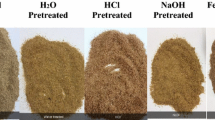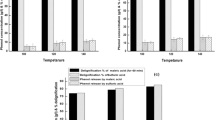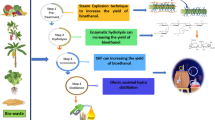Abstract
The present work is focused on the yield of bioethanol using chemical and non-chemical pre-treatment techniques. Textile cotton waste is taken as the biomass for the present work. The acid and ultrasonication pre-treatment has been chosen as chemical and non-chemical method respectively. Experiments were carried out with acid and ultrasonication pre-treatment techniques by varying different parameters. The compositional analysis was done using the Soxhlet extraction method to find the cellulose, hemicellulose and lignin content. The functional group changes were confirmed by FT-IR analysis. The sugar yield is measured using Di Nitro Salicylic acid method. The increase in sugar yield is confirmed after pre-treatment and the samples were taken into fermentation process. The fermentation is done by using Saccharomyces cerevisiae. The yeast is initially inoculated in the YPD medium. The grown yeast is used in the fermentation process for the production of bioethanol. The presence of bioethanol is confirmed using GC analysis and yield of bioethanol produced using acid, ultrasonic pre-treatment and solvent treatment is compared. It is also noticed that acid, ultrasonicated and solvent pre-treatment biomass shows 0.58 g/l, 0.543 ml/g and 0.334 ml/g of bioethanol respectively.



Similar content being viewed by others
References
Binder, J. B., & Raines, R. T. (2010). Fermentable sugars by chemical hydrolysis of biomass. Proceedings of the National Academy of Sciences,107, 4516–4521.
Chandrashekhar, B., et al. (2011). Bio-Ethanol production from textile cotton waste via dilute acid hydrolysis and fermentation by Saccharomyces cerevisiae. Journal of Ecobiotechnology,3(4), 6–9.
Chen, Y., & Mu, T. (2019). Application of deep eutectic solvents in biomass pretreatment and conversion. Green Energy & Environment,2, 95–115.
Chilari, D. L., et al. (2017). Bioethanol production from alkali-treated cotton stalks at high solids loading applying non-isothermal simultaneous saccharification and fermentation. Waste Biomass Valorization,8, 1919–1929.
Deng, Z., et al. (2019). Laccase pretreatment of wheat straw: Effects of the physicochemical characteristics and the kinetics of enzymatic hydrolysis. Biotechnology for Biofuels,12(159), 1–12.
Elahe, G., Keikhosro, K., & Mahmood, M. (2014). Effective conversion of waste polyester–cotton textile to ethanol and recovery of polyester by alkaline pretreatment. Chemical Engineering Journal,253, 40–45.
Gopinath, S. M., et al. (2015). Production of bioethanol from lignocellulosic biomass by simultaneous saccharification and fermentation. International Journal of Science and Research,4, 147–151.
Hsieh, Y.-L. (2007). Chemical structure and properties of cotton. In S. Gordon & Y. L. Hsieh (Eds.), Cotton: Science and technology, chapter 1 (pp. 3–34). Cambridge: Woodhead Publishing Limited.
Jayashri, N., Deepthi, J., & Kalyani, S. K. (2013). Study of biodiesel blends and emission characteristics of biodiesel. International Journal of Science and Research,2, 3710–3715.
Keshav, P. K., Naseeruddin, S., & Venkateswar Rao, L. (2016). Improved enzymatic saccharification of steam exploded cotton stalk using alkaline extraction and fermentation of cellulosic sugars into ethanol. Bioresource Technology,214, 363–370.
Lavanya, M., Meenakshisundaram, A., & Renganathan, S. (2016). Hydrothermal liquefaction of freshwater and marine algal biomass: A novel approach to produce distillate fuel fractions through blending and co-processing of biocrude with petrocrude. Bioresource Technology,203, 228–235.
Li, H., et al. (2016). Microwave irradiation—A green and efficient way to pretreat biomass. Bioresource Technology,199, 34–41.
Ling, Z., et al. (2019). Structural variations of cotton cellulose nanocrystals from deep eutectic solvent treatment: Micro and nano scale. Cellulose,26, 861–876.
Liu, Y., et al. (2017). Efficient cleavage of strong hydrogen bonds in cotton by deep eutectic solvents and facile fabrication of cellulose nanocrystals in high yields. ACS Sustainable Chemistry & Engineering,5(9), 7623–7631.
Lopez-Abelairas, M., et al. (2013). Optimisation of the biological pretreatment of wheat straw with white-rot fungi for ethanol production. Bioprocess Biosystems Engineering,36, 1251–1260.
Maczynska, J., et al. (2019). Production and use of biofuels for transport in Poland and Brazil—The case of bioethanol. Fuel,241, 989–996.
Miller, G. L. (1959). Use of dinitrosalicylic acid reagent for determination of reducing sugar. Analytical Chemistry,31, 426–428.
Nikolic, S., et al. (2017). Production of bioethanol from pre-treated cotton fabrics and waste cotton materials. Carbohydrate Polymers,164, 136–144.
Parveen, K., et al. (2009). Methods for pretreatment of lignocellulosic biomass for efficient hydrolysis and biofuel production. Industrial & Chemistry Research,48, 3713–3729.
Placido, J., Tahmina, I., & Sergio, C. (2013). Evaluation of ligninolytic enzymes, ultrasonication and liquid hot water as pretreatments for bioethanol production from cotton gin trash. Bioresource Technology,139, 203–208.
Ranjithkumar, M., et al. (2017). An effective conversion of cotton waste biomass to ethanol: A critical review on pretreatment processes. Waste Biomass Valorization,8, 57–68.
Ray, M. J., et al. (2010). Brown rot fungal early stage decay mechanism as a biological pretreatment for softwood biomass in biofuel production. Biomass and Bioenergy.,34, 1257–1262.
Shahzad, K., Sohail, M., & Hamid, A. (2019). Green ethanol production from cotton stalk. IOP Conference Series: Earth and Environmental Science,257, 12025.
Subhedar, P. B., & Gogate, P. R. (2018). Use of ultrasound for pretreatment of biomass and subsequent hydrolysis and fermentation. In S. I. Mussatto (Ed.), Biomass Fractionation technologies for a lignocellulosic feedstock based biorefinery, chapter 6 (pp. 127–149). Amsterdam: Elsevier.
Thakore, K. A., & Aabate, B. (2017). Application of ultrasound in the pre-treatment of cotton fabric. Cellulose Chemistry Technology,51, 983–992.
Toda, M., et al. (2015). Quantitative examination of pre-extraction treatment on the determination of lignin content in leaves. BioResources,10, 2328–2337.
Travaini, R., Barrado, E., & Bolado-rodríguez, S. (2016). Effect of ozonolysis pretreatment parameters on the sugar release, ozone consumption and ethanol production from sugarcane bagasse. Bioresource Technology,214, 150–158.
Wang, M., et al. (2016). Bioethanol production from cotton stalk: A comparative study of various pretreatments. Fuel,184, 527–532.
Xue, C., et al. (2016). The vital role of citrate buffer in acetone–butanol–ethanol (ABE) fermentation using corn stover and high-efficient product recovery by vapor stripping–vapor permeation (VSVP) process. Biotechnology for Biofuels,9, 146.
Yu, Z., & Zhang, H. (2003). Pretreatments of cellulose pyrolysate for ethanol production by Saccharomyces cerevisiae, Pichia sp. YZ-1 and Zymomonas mobilis. Biomass and Bioenergy,24, 257–262.
Acknowledgements
The authors are thankful to the Chemical Engineering Department for providing necessary infrastructure, resources and instrument facilities to accomplish this work.
Author information
Authors and Affiliations
Corresponding author
Rights and permissions
About this article
Cite this article
Megala, S., Rekha, B. & Saravanathamizhan, R. Chemical and non-chemical pre-treatment techniques for bio ethanol production from biomass. Int J Energ Water Res 4, 199–204 (2020). https://doi.org/10.1007/s42108-020-00064-7
Received:
Accepted:
Published:
Issue Date:
DOI: https://doi.org/10.1007/s42108-020-00064-7




